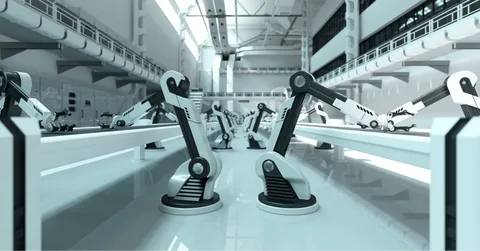Automation is no longer a luxury for large manufacturers — it’s becoming a necessity across industries. At the core of this technological shift are innovations from the modern 3D robotics company, blending mechanical precision with advanced computer vision. These companies are redefining what’s possible in factories, farms, warehouses, and even hospitals by equipping machines with the power of sight and real-time decision-making. With the support of 3D imaging, AI, and robotics integration, industries can now automate complex tasks that once required human intuition.
One company pushing the boundaries in this space is MRDVS, known for its high-performance 3D vision cameras built specifically for seamless robotic integration and industrial-grade accuracy.
In this article, we’ll explore how 3D robotics companies operate, the tech they use, where they’re making an impact, how to evaluate them, and what trends are defining the future of robotics powered by smart vision.
What Does a 3D Robotics Company Do?
A 3D robotics company builds intelligent robotic systems equipped with 3D visual capabilities. This means robots aren’t just following pre-programmed paths — they can “see” their environment, measure distances, recognize shapes, and adapt their actions based on real-world input. The result is a more flexible, precise, and autonomous machine that can handle dynamic environments and complex workflows.
Instead of relying on basic sensors, these systems use high-resolution 3D cameras combined with software algorithms to understand their surroundings. A robotic arm can align with a moving part. A drone can scan terrain and avoid obstacles. An automated forklift can identify pallets and navigate safely. All this is possible because of real-time visual feedback.
Core Technologies Behind 3D Robotics Companies
To give robots these enhanced capabilities, 3D robotics companies combine several powerful technologies. Each component plays a vital role in giving machines the ability to “think with their eyes.”
Key technologies include:
- 3D vision cameras: Using stereo vision, ToF (Time-of-Flight), or structured light to map environments with depth and clarity.
- AI-based object recognition: Helps robots distinguish between tools, parts, humans, or hazards.
- Edge computing: Reduces lag by processing visual data directly on the device.
- SLAM (Simultaneous Localization and Mapping): Allows mobile robots to navigate by constantly updating their position and surroundings.
- Sensor fusion: Combines input from multiple sensors (camera, LiDAR, ultrasonic) for richer understanding.
These systems let robots function more like humans: seeing, thinking, reacting — and learning.
Real-World Applications of 3D Robotics Technology
The use of 3D robotics is growing rapidly across multiple industries. As tasks become more complex and labor becomes harder to source, businesses are turning to 3D robotic systems for smarter automation.
Manufacturing & Assembly
Robots with 3D vision can handle parts with varying sizes, orientations, or defects. They’re used for:
- Visual inspection and defect detection
- Bin picking and random part alignment
- High-precision welding and gluing
Warehousing & Logistics
3D robotics systems guide autonomous mobile robots (AMRs) through crowded warehouses. Vision systems allow them to:
- Avoid collisions and detect humans
- Scan and identify packages
- Adapt routes dynamically
Healthcare & Surgery
In surgical robots, 3D cameras guide instruments with millimeter precision. These systems are also used in diagnostics, lab automation, and telehealth applications.
Agriculture & Food Processing
Smart agricultural robots use 3D vision to detect ripe produce, avoid damaging crops, and work in fields with irregular terrain.
Smart Cities & Construction
Robots equipped with 3D vision can perform site surveys, manage inventory, and inspect building structures for defects or safety issues.
Benefits of Partnering with a 3D Robotics Company
Working with a specialized 3D robotics company can transform your operations by adding intelligence and adaptability to machines. Key benefits include:
- Greater precision: Execute tasks down to millimeter-level accuracy.
- Real-time adaptability: React to unexpected changes or object movement.
- Fewer human errors: Machines make consistent, data-driven decisions.
- Improved safety: Robots can detect and avoid people or hazards.
- Scalability: Vision systems can grow from one robot to dozens, coordinated across systems.
By leveraging these systems, companies can gain a competitive edge in speed, quality, and flexibility. Just as advanced security cameras for home improve safety through smart monitoring, 3D vision in robotics enhances workplace security, accuracy, and automation on a much larger scale.
How to Choose the Right 3D Robotics Company
Not every robotics provider will be right for your use case. Look for a partner that understands both the hardware and software components of vision-integrated automation.
Checklist for evaluating a 3D robotics company:
- Do they offer real-time 3D imaging solutions?
- Are their systems compatible with your robots and software stack?
- Do they support your industry-specific standards and environments?
- Do they offer SDKs, APIs, or development tools for easy integration?
- Is their hardware rugged and scalable for your operational needs?
Feature Comparison Table: What to Look For
| Feature | Why It Matters | Ideal Specification |
| 3D Camera Resolution | Affects detail in visual inspection and detection | 1 MP or higher with depth accuracy <1mm |
| Frame Rate | Needed for fast-moving tasks | 30 FPS minimum; 60+ for dynamic environments |
| Field of View | Wider view means fewer blind spots | 70–120° horizontal FOV |
| AI & Edge Processing | Enables fast decision-making on-device | GPU/AI chip onboard (e.g., Jetson, Movidius) |
| Industrial Durability | Must withstand dust, heat, vibration | IP65+ rating and metal casing preferred |
Choose a vendor that not only checks these boxes, but also has real-world experience deploying systems in environments like yours.
Trends Defining the Future of 3D Robotics
The 3D robotics industry continues to grow as costs fall and capabilities rise. Here are a few key trends:
AI at the Edge
More companies are integrating edge-AI directly into cameras, enabling faster decisions and reduced reliance on cloud infrastructure. This is essential in latency-sensitive tasks like automated inspection or real-time path planning.
Miniaturization of Hardware
Smaller, more efficient 3D cameras are allowing integration into compact robots, drones, and wearable systems. This opens doors for robotics in smaller businesses and even consumer applications.
Vision-as-a-Service (VaaS)
Some 3D robotics companies now offer subscription-based models. This allows companies to pay monthly instead of investing heavily up front, while receiving software updates and hardware support.
Integration with Cloud Robotics
Cloud-connected 3D robotics allow fleet-level management, performance monitoring, and AI model updates from anywhere in the world — a major benefit for global companies or those operating across multiple sites.
Use Cases and Success Stories
Smart Packing Line
A leading electronics brand deployed 3D robotic arms for final assembly and packaging. With vision-enabled alignment, error rates dropped by 35%, and throughput increased by 20% over 6 months.
Autonomous Farming Robot
A startup in California used 3D vision-guided harvesters to detect fruit ripeness and minimize waste. The robots achieved a 94% accuracy rate in picking only mature produce.
Warehouse Navigation
A logistics firm installed vision-guided mobile robots with SLAM capabilities. The 3D vision allowed real-time route optimization and human avoidance, improving delivery speeds by 40%. Similar smart monitoring can also be seen in aosu security cameras, where motion detection and automation enhance residential safety and responsiveness.
Final Thoughts: Why 3D Robotics Companies Are Reshaping the Future
From smart factories to precision farming, the influence of a 3D robotics company is impossible to ignore. These innovators are providing the eyes and intelligence that turn ordinary machines into autonomous, adaptable problem-solvers. Whether you’re looking to cut costs, increase efficiency, or lead in innovation, integrating 3D vision into your automation strategy is a clear path forward.
With cutting-edge advancements in AI, edge computing, and real-time imaging, now is the perfect time to explore how 3D robotics can elevate your operations.


